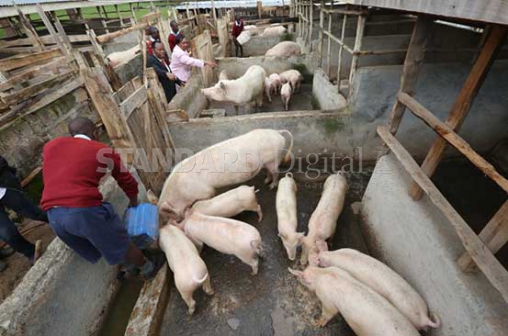
Two weeks ago, I wrote extensively about how to start a pig farm and I promised to continue on the same trajectory. This week we continue on taking care of piglets and pig diseases.
Having established a good pig house, known the source of feed for your pigs and finally stocked with a pig breed of choice it’s all systems go. Next step is to identify a qualified vet (possesses a Kenya Veterinary Board (KVB) identity card) who will provide you with clinical services.
Pigs like poultry, are affected by viral diseases that can wipe a whole herd.
The first step towards having a healthy herd is getting a boar (male pig) with superior qualities, which will in turn transfer these desirable qualities to their offspring.
A reproductively sound boar should be selected from the best parents. Such should have exhibited high feed conversion rates, high weaning rates and high reproductive potential.
This selection should be done before castration which is usually done by the time the animal is four weeks old.
Other desirable characteristics of the boar should include sound feet with good, full hams, uniform curve at the back and good body length.
Boar should be selected from the herd with normal sex organs and should be active, healthy and strong. A boar selected under these criteria must be at least 8 months old at first service.
Mating routine
Once a farmer is assured of a boar with top desired characteristics, sows (female pig) must be carefully observed for heat so that no service is skipped.
Signs that a pig is on heat are restlessness, reddened and swollen vulva with white mucus discharge which later turns slimy.
Like cows, sows or gilts on heat tend to mount and be mounted by others. The most specific indicator of heat and readiness for service is when the sow or gilt stands still when pressure is applied to her back (standing heat).
More commonly, a sow may delay coming on heat and this is usually after farrowing. To bring the sow to heat, spray the sow’s (or gilt’s) pen with boar urine every morning for three to five days. Bring the sow to the boar, or place the sow in a pen next to the boar or put the sow together with the boar for a short period every day when the heat is expected.
Always take the sow to the boar as This activity makes the sow smell the characteristic boar smell which stimulates heat. Early weaning at 4 to 6 weeks also helps a sow return to heat fast.
Stay informed. Subscribe to our newsletter
During standing heat period which lasts 24 hours, allow the boar to serve twice at an interval of about 12 to 14 hours. Do not mate animals during the hot time of day as it’s stressful. Young boars may need assistance in alignment during mating.
When aiding in this process, ensure your hands are clean and nails short. If conception is not successful, the sow will return on heat again in about three weeks. It is usually advisable to increase feed by 1 - 2 kg per day since it is a stressing period with increased activity for the sow. In case of successful a pregnancy, it is good practice to, give 0.5 kg extra feed per day in the last trimester but decrease this gradually one week before farrowing. Provide plenty of water to help prevent congested gut during farrowing. Failure of conception can be due to various factors including if the sow is too fat, gilt in her first heat cycle, immature boars and in some cases when the boar is overworked (used for more than five matings a week).
Care and management of new born piglets
Soon after birth, the umbilical cord must be snapped off at approximately 5 cm from the body. It should then be dipped in iodine to prevent infections that lead can lead to tetanus. Assist the piglets to begin suckling immediately. Colostrum intake boosts the young animal’s immunity, thus all piglets should suckle sufficiently within the first 12 to 24 hours of life. Sometimes when piglets are many, they can be supplemented with goat or cow milk.
Piglets are usually born with needle sharp teeth that can injure the sow udder. These have to be trimmed on day one it must be done by skilled personnel to avoid injury to the piglet. Days after birth, piglets suffer from iron deficiency anaemia and therefore have to be supplemented orally within 24 to 48 hours after birth or by iron injections.
Male piglets are castrated within the first two weeks to prevent their meat from having the boar taint. Castration also makes them more manageable when they become sexually mature.
Note that castration equipment must also be clean and after castration, the wound must be disinfected to prevent infections.
To reduce cases of cannibalism where piglets bite their tails, the body part can be cut by day four. To avoid this habit, chains can be hung in the shed for the pigs to bite when the urge comes.
To keep the piglets warm especially during the cold weather, infrared bulbs come in handy. To ensure more litter from a sow in a year, encourage early weaning from two weeks but this must be accompanied by provision of quality balanced nutrients.
Common pig diseases and parasites
Now that you have your piglets, the next thing you need to look out for is pig diseases. To avoid disease incidences, it is important to have a clean house, quality feed and ensure general wellness of the pigs. As expected, even after taking all the biosecurity measures, the animals may still get sick because of other factors.
Common signs of ill health in pigs include reduced appetite, rapid breathing, indication of a fever, in white skin-coloured pigs the skin may become reddish or bluish.
Depending on the system affected some pigs may have diarrhoea which may be bloody. Droopy ears or ears pointing downwards, dull eyes are also indicative of sick pigs. To be on the safe side, always call a vet when you spot these symptoms.
- The writer is a veterinarian surgeon based at the University of Nairobi
 The Standard Group Plc is a
multi-media organization with investments in media platforms spanning newspaper
print operations, television, radio broadcasting, digital and online services. The
Standard Group is recognized as a leading multi-media house in Kenya with a key
influence in matters of national and international interest.
The Standard Group Plc is a
multi-media organization with investments in media platforms spanning newspaper
print operations, television, radio broadcasting, digital and online services. The
Standard Group is recognized as a leading multi-media house in Kenya with a key
influence in matters of national and international interest.
 The Standard Group Plc is a
multi-media organization with investments in media platforms spanning newspaper
print operations, television, radio broadcasting, digital and online services. The
Standard Group is recognized as a leading multi-media house in Kenya with a key
influence in matters of national and international interest.
The Standard Group Plc is a
multi-media organization with investments in media platforms spanning newspaper
print operations, television, radio broadcasting, digital and online services. The
Standard Group is recognized as a leading multi-media house in Kenya with a key
influence in matters of national and international interest.






